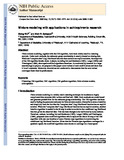Mixture modeling with applications in schizophrenia research
Author
Wu, Qiang; Sampson, Allan R.
Abstract
Finite mixture modeling, together with the EM algorithm, have been widely used in clustering analysis. Under such methods, the unknown group membership is usually treated as missing data. When the "complete data" (log-)likelihood function does not have an explicit solution, the simplicity of the EM algorithm breaks down. Authors, including Rai and Matthews (1993), Lange (1995a) and Titterington (1984), developed modified algorithms therefore. As motivated by research in a large neurobiological project, we propose in this paper a new variant of such modifications and show that it is self-consistent. Moreover, simulations are conducted to demonstrate that the new variant converges faster than its predecessors. Originally published Computational Statistics and Data Analysis, Vol. 53, No. 7, May 2009
Date
2009-05-15
Citation:
APA:
Wu, Qiang, & Sampson, Allan R.. (May 2009).
Mixture modeling with applications in schizophrenia research.
Computational Statistics and Data Analysis,
53(7),
2563-
2572. Retrieved from
http://hdl.handle.net/10342/3120
MLA:
Wu, Qiang, and Sampson, Allan R..
"Mixture modeling with applications in schizophrenia research". Computational Statistics and Data Analysis.
53:7. (2563-2572),
May 2009.
June 29, 2024.
http://hdl.handle.net/10342/3120.
Chicago:
Wu, Qiang and Sampson, Allan R.,
"Mixture modeling with applications in schizophrenia research," Computational Statistics and Data Analysis 53, no.
7 (May 2009),
http://hdl.handle.net/10342/3120 (accessed
June 29, 2024).
AMA:
Wu, Qiang, Sampson, Allan R..
Mixture modeling with applications in schizophrenia research. Computational Statistics and Data Analysis.
May 2009;
53(7):
2563-2572.
http://hdl.handle.net/10342/3120. Accessed
June 29, 2024.
Collections
Publisher
East Carolina University

